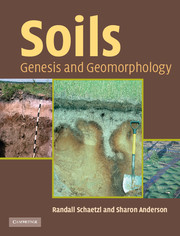Book contents
- Frontmatter
- Contents
- Preface
- Acknowledgements
- Part I The building blocks of the soil
- Part II Soil genesis: from parent material to soil
- 8 Soil parent materials
- 9 Weathering
- 10 Pedoturbation
- 11 Models and concepts of soil formation
- 12 Soil genesis and profile differentiation
- Part III Soil geomorphology
- References
- Glossary
- Index
9 - Weathering
from Part II - Soil genesis: from parent material to soil
- Frontmatter
- Contents
- Preface
- Acknowledgements
- Part I The building blocks of the soil
- Part II Soil genesis: from parent material to soil
- 8 Soil parent materials
- 9 Weathering
- 10 Pedoturbation
- 11 Models and concepts of soil formation
- 12 Soil genesis and profile differentiation
- Part III Soil geomorphology
- References
- Glossary
- Index
Summary
An important step in the formation of soil from rock involves weathering of the rock into smaller and/or chemically altered parts (Yatsu 1988). Weathering is the physical and chemical alteration of rocks and minerals at or near the Earth's surface, produced by biological, chemical and physical agents or their combination, as they adjust toward an equilibrium state in the surface environment (Pope et al. 2002). Few soils form directly from bedrock. Usually there is an intermediate step in which weathering processes form residuum from the rock, or geomorphic processes comminute and erode it, forming various types of regolith. Both are then acted upon by pedogenic processes to form soil (see Chapter 12). In the end, rocks become discolored, structurally altered, acquire precipitates of weathering by-products and experience surface recession as a result of weathering. In this section we briefly examine the main components and processes of weathering; it logically follows on our treatise of soil parent materials in Chapter 8.
Rocks are variously physically and chemically unstable at the Earth's surface, and hence they weather, because this environment is far different from the one in which they formed. For most rocks, the surface (soil) environment is colder, with less pressure and increased amounts of oxygen, water and biota, than their formative environment, be it below the sea floor or deep within the crust. As noted in Chapter 4, minerals formed in such environments are often primary minerals.
- Type
- Chapter
- Information
- SoilsGenesis and Geomorphology, pp. 226 - 238Publisher: Cambridge University PressPrint publication year: 2005
- 1
- Cited by

